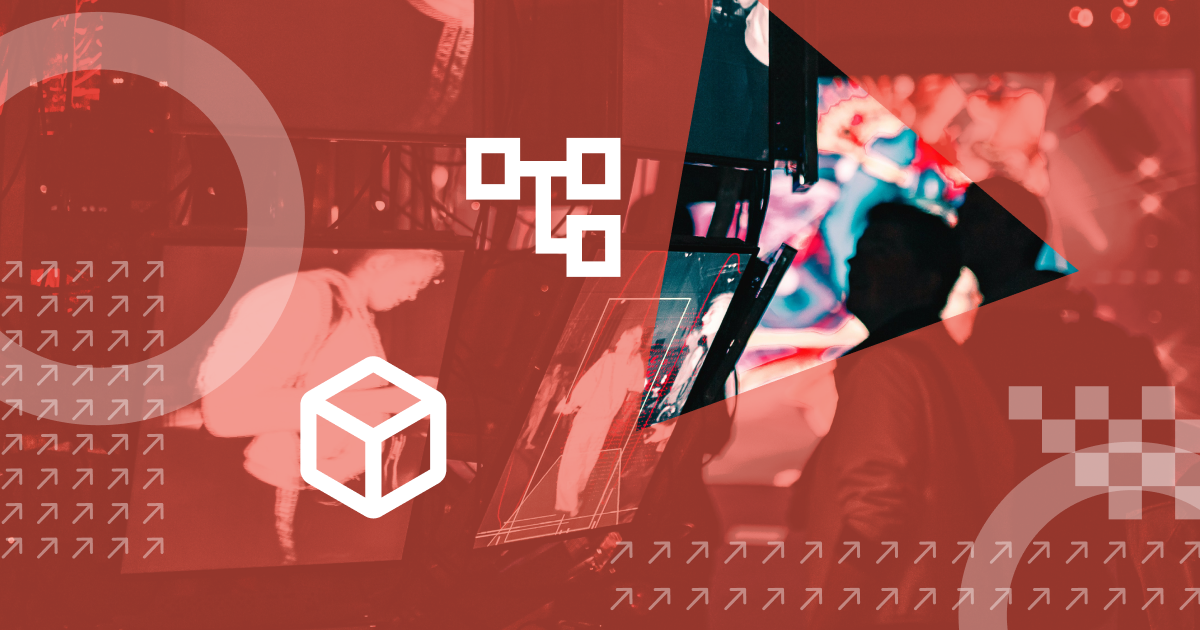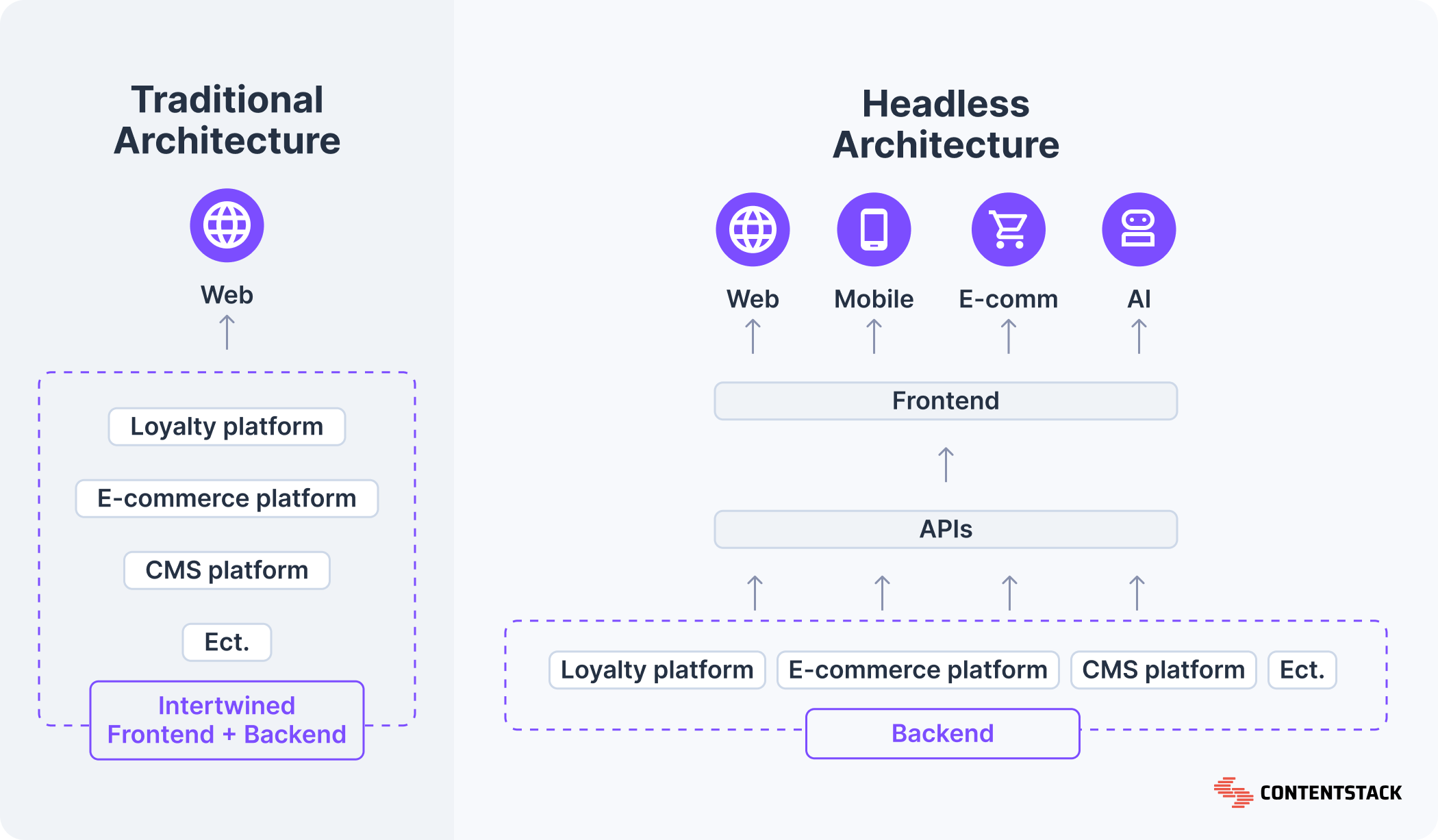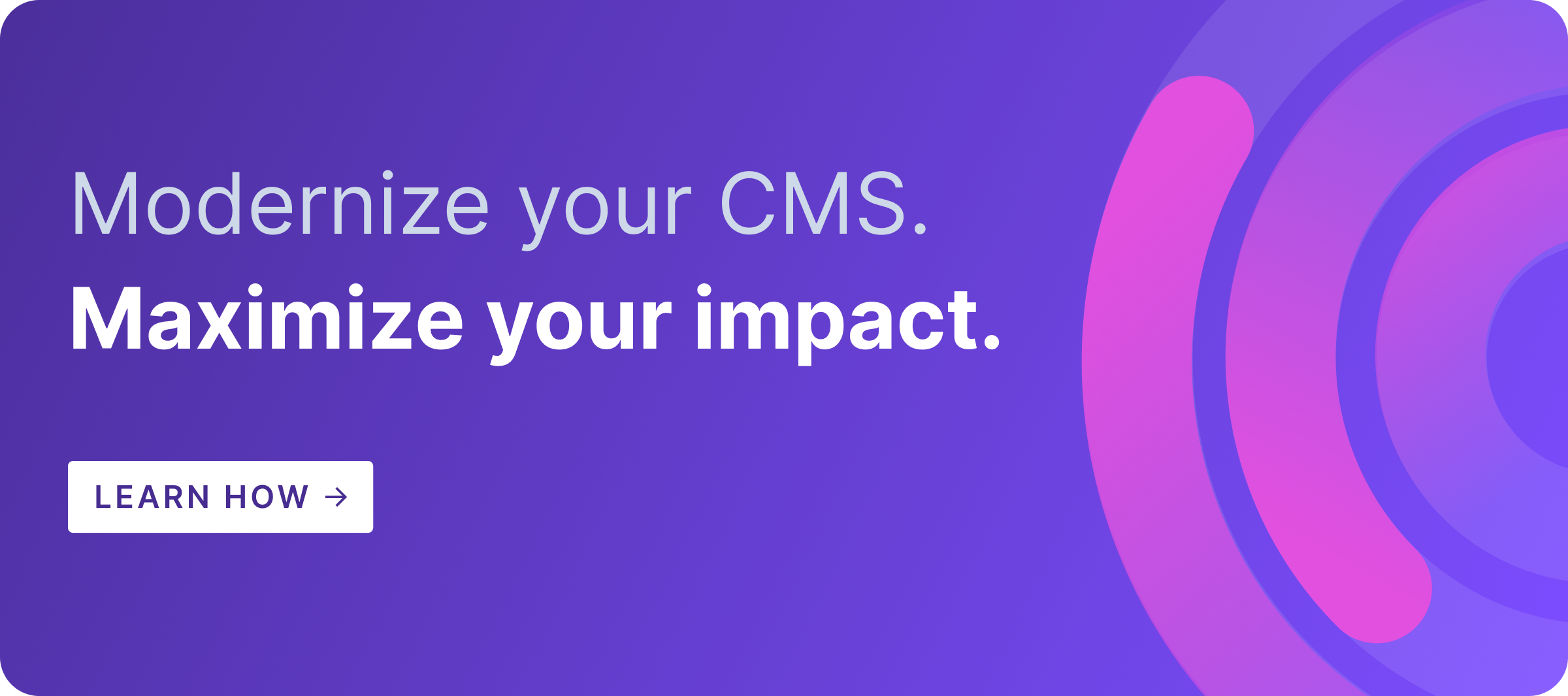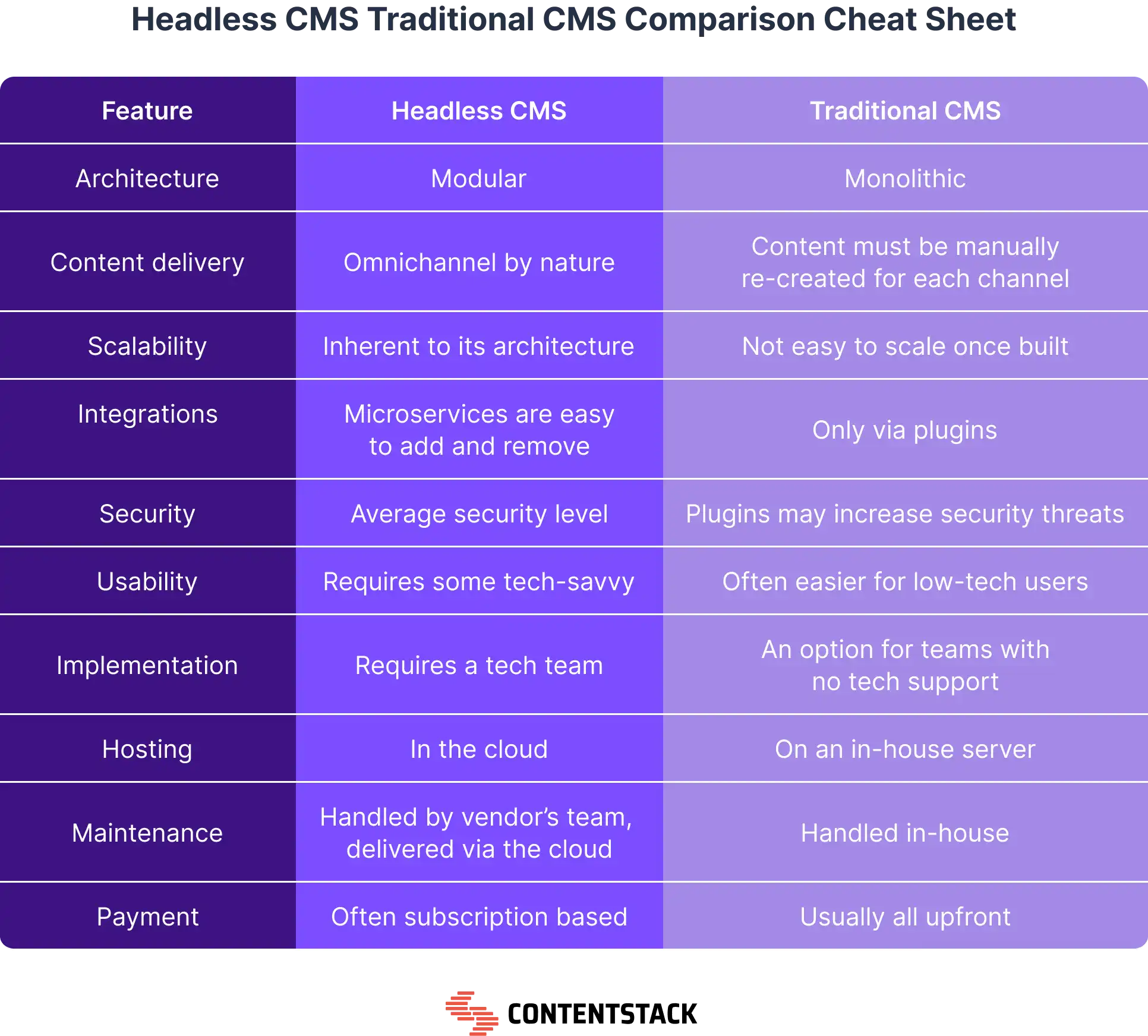Headless CMS vs. traditional CMS: how to pick your best fit

If you’re searching for a new content management system, a common term you’ve likely seen is “headless CMS.” In this article, we’ll explain what a “headless” content management system is, how it compares to other content management systems, and which might work best for you.
What is a content management system?
A content management system, or CMS, is a software platform that allows business users to create and publish content without needing to understand code. Depending on the CMS, content can be delivered to a website, mobile application, or other digital technologies.
CMS platforms are a primary tool for creating and managing content. Many modern CMS solutions have collaboration and governance features that help control content throughout its lifecycle.
For more background on the development of the CMS, read History of Content Management Systems and Rise of Headless CMS.
Headless CMS vs. traditional CMS
Let's review two high-level content management systems: the traditional CMS and its modern spinoff, the headless CMS.
How to build the business case for headless CMS vs. traditional CMS
Here’s what you need to know about each.

The ins and outs of headless CMS
Headless CMS disconnects the back end (aka the “body”) of the platform where content is created, managed, and stored from the front-end (aka the “head”) of the platform where content is formatted, designed, and distributed. Application programming interface (API) technology enables both sides of the platform to communicate and work together as needed – at the same time.
This structure makes a headless CMS flexible and approachable for businesses with heavy and variable content needs. Marketing and content teams can create, manage, and store content in reusable modules. At the same time, designers and developers can access apps and integrations, and languages to build cutting-edge workflows that deliver this content to dynamic website pages, smartwatch apps, chatbots, and other digital experiences.
Next, we’ll discuss some of the most essential features that powerful headless CMS solutions share.
Overcome traditional CMS issues with Contentstack: Are you tired of slow development times and rising costs due to legacy monolithic suites? Contentstack offers a modern, component-based solution designed for the needs of today's enterprises. Discover agility and improved ROI. Request a demo to learn more.
APIs
The application programming interface is a key feature of the headless CMS. Headless CMSes are sometimes called API-first CMSes. Some APIs deliver content to omnichannel digital experiences. Other APIs create communication channels between applications so these tools can work together to optimize content modules. When injected into the content, these applications often contain information about customers or products, making it more personalized to the consumer and the situation.
Integration ability
Thanks to the flexible and loosely connected (via API) structure of headless CMSes, you’re always ready for the subsequent integration.
A headless CMS makes it simple for developers to plug in third-party applications to enrich content. Users often integrate customer relationship management (CRM) platforms, product information management (PIM) software, enterprise resource planning (ERP) tools, full-stack automation programs, analytics tools, and other applications. These enable marketing teams to create fast, personalized, and cohesive content-driven experiences on a large scale.
Content management tools
An effective headless CMS should have rich text-editing capabilities, flexible content models and modules, creation and approval workflows, rules and permission settings, content previews, publishing automation, and more.
Developer resources
Headless CMS software should make life as easy for developers as it does for marketers. It should feature development resources such as webhooks, frameworks, SDKs, easy-to-use APIs, DevOps services, detailed documentation, and customer support.

All about traditional CMS
Traditional content management systems empower users to create, manage, and publish content. The main difference from headless CMSes is that traditional systems are monolithic in structure, meaning the back end and front end are tightly coupled in a single technical area. Once a content asset has been published, it’s in its final state in this structure. In a traditional system, content isn’t stored in modules, making content assets difficult to reformat or reuse. Adding new functionality or features to a traditional CMS is also difficult as it requires using a plugin versus an integration.
There are some features that monolithic traditional CMSs share.
Monolithic platform
The core feature of a traditional CMS is a single monolithic platform that feeds content to a website. This architecture makes it an out-of-the-box solution that sacrifices flexibility for ease of use without development support.
Templates + Plugins
Because traditional CMSes were created to deliver content to websites alone, so they don’t need much flexibility to serve content. This is why they rely on templates for displaying content. These templates are not easily edited, nor are they meant to be. This structure is ideal for business users but gets complicated quickly if you want to change any features or functionality.
The best users can do to customize their traditional CMS instance is to add plugins. Plugins are pre-made applications that can be added to a traditional CMS. However, they’re more like a Band-Aid than a true integration, as they’re workarounds built to break through the tough shell of the monolith.
Content management tools
A traditional CMS is heavily focused on content management features. These can include robust text formatting, digital asset management, version tracking, permissions, WYSIWYG editors and that enable marketers to see how the content they’re creating will appear on the live website.
Simplicity for business users
Ease of use leads many companies that don’t have development resources to choose a traditional CMS. When a simple, website-based experience is all you’re looking to create, traditional CMS is an easy choice.
How each CMS measures up in three key areas
Now let’s look more closely at headless and traditional CMS and how each measures up in three key areas: meeting content creators’ needs, optimizing user experience, and efficiently distributing content.
Which is better for content creators’ needs?
Marketing managers and developers continually seek new ways to create content that engages audiences and delivers results. Let’s look at the requirements and expectations of content creators while discussing the differences in workflows between headless and traditional CMS. We'll also examine the impact CMS choice has on content creators' efficiency and creativity.
While various headless CMS options are available today, they have specific features and benefits that attract content creators. Among these are:
- Real-time collaboration: Cloud-based headless CMS often provides a platform for content creators to work together on projects. This facilitates seamless teamwork and faster project completion.
- Content APIs: With content APIs, a headless CMS platform enables content creators to deliver content across multiple channels and devices quickly.
- User experience: A headless CMS platform prioritizes the user experience. It offers intuitive interfaces and easy navigation and focuses on helping content creators manage content and digital assets more efficiently.
How content creation workflows differ between headless and traditional CMS
Headless CMS software allows content creators to work on projects without worrying about the front-end presentation layer. It separates content management from content delivery. This allows creators to focus on organizing digital assets and entering data into the system. Decoupling the front and back ends gives developers greater control over design and functionality choices.
Headless CMS solutions use a content delivery network (CDN) to distribute content globally and efficiently. This facilitates faster website performance and more accessible content management for different channels, accommodating the diverse ways audiences consume content today.
Traditional CMS platforms like WordPress or Drupal include content management and presentation layers. They can be easier to set up and use for content creators who don't require advanced technical knowledge.
However, traditional CMS platforms require a deeper understanding of the platform's limitations and features. For example, using pre-built templates and plugins might impact the flexibility of content creators when they want to make more bespoke design decisions.
The impact of CMS choice on content creators' efficiency and creativity
Content creators thrive when given tools and processes designed to make their jobs easier. The choice between headless and traditional CMS can influence how efficiently and creatively they work.
Efficiency
Headless CMS offers greater efficiency due to real-time collaboration features and cloud-based infrastructure. Moreover, this modern CMS approach fits better into agile project management methodologies, further boosting efficiency.
In contrast, traditional CMS platforms may require more time to manage site infrastructure and maintain updates, limiting content creators' efficiency.
Creativity
Headless CMS encourages creativity by providing content creators with a platform to focus on content creation without the rigid constraints of predefined templates. This gives them the freedom to create truly unique experiences across different channels.
We can draw several conclusions when we analyze user experiences in headless CMS and traditional CMS environments. Choosing the right headless CMS solutions can:
- Empower content creators by providing real-time collaboration tools, improving productivity and creativity.
- Allow content curators to distribute content across multiple channels through unified APIs, optimizing the user experience.
- Enhance load times and website performance.
In contrast, traditional CMS platforms could potentially:
- Hinder content creators' flexibility and creativity due to rigid structure and limited customization options.
- Cause website performance issues if the platform is bloated with plugins and themes.
- Limit content distribution channels, as traditional CMS platforms usually prioritize web output.
While traditional CMS platforms can still foster creativity, their dependence on templates and plugins might restrict the content creators' ability to innovate and customize their work.
Which is better for optimizing user experience?
Headless CMS improves user experience by delivering personalized content across multiple devices, channels, and touchpoints. Delivering content through a CDN guarantees speed, reliability, and high performance.
Traditional CMS platforms, on the other hand, have a relatively rigid content delivery system that affects user experience. They cannot deliver real-time content, which may impact user experience.
Examples of improved user experience with headless CMS
Marketing teams reap many rewards when leveraging headless CMS solutions to enhance the user experience. Here are real-world examples of how the Contentstack headless CMS has helped businesses improve user experience.
GetYourGuide case study
After implementing Contentstack, GetYourGuide’s technical and non-technical users were empowered to create new experiences and deliver content more than 90% faster than with previous methods. They now deliver personalized, optimized content to more than 500,000 users daily.
By transitioning to headless, this leading global travel brand also improved engagement with high-value audiences by creating richer, more profound digital experiences that included videos, influencer content, and more.
To learn more, read the entire case study.
Leesa case study
This American mattress company, Leesa, switched to Contentstack to optimize its website for speed and user experience. After implementing the headless solution, Leesa could personalize content at scale and drive 30 times more traffic through its articles.
When a customer or prospect lands on the Leesa website to read a topical article, the company can track the blog's topic, identifying the customer segment or interest. Inside the article, Leesa can insert targeted product recommendations and direct to a personalized product page around this specific topic when the customer clicks out using a call to action.
To learn more, read the entire case study.
Contentstack: A Leader in CMS Performance. Experience the strength of Contentstack, a standout performer in Forrester's Q3 2023 CMS report. Contentstack simplifies your digital experience with our back-end extensibility and global deployments. Request a demo to learn more.
Which is better for efficiently distributing content?
The choice of CMS type significantly impacts managing and optimizing content distribution. This has been a hot topic recently, where many are rushing to adopt headless CMS solutions while others are sticking to traditional CMS platforms.
Content distribution is all about delivering content to potential customers. In the digital landscape, delivering content beyond one's channels is essential to gain a competitive edge. The right approach ensures your content reaches the target audience at the right time and place. The essence of content distribution is to generate high-quality leads, drive traffic to websites, improve search engine rankings, and increase brand visibility.
Traditional CMS platforms hold content in predefined web templates that blend content presentation with back-end structure. On the other hand, headless CMS separates the front end from the back end and stores content separately. The latter makes it easier to deliver content on various channels.
An organization can use headless CMS to deliver content on any channel, from mobile and web applications to smartwatches and IoT devices. In contrast, traditional CMS confines content creators only to deliver on the web.
Headless CMS provides a better solution to deliver content to different devices, channels, and formats. With headless CMS, you can rapidly respond to changing market demands and easily adapt to new technologies.
What caused the split between headless CMS and traditional CMS?
Static websites were once the extent of the digital experience. For this purpose, the traditional CMS infrastructure was sufficient.
However, experiences today are anything but static. The internet has brought a web of Internet of Things (IoT) devices and digital channels to life. Consumers seek personalized, cohesive, and always-on experiences using these devices and channels.
Headless CMS was created to deliver these experiences. Vendors saw a need to make content reusable and connect content management tools companies were already using. Headless CMSes simplify large-scale content creation, optimization, delivery, and republishing.

You may need a headless CMS if…
1. Marketing is currently managing several CMS platforms
With headless CMS options on the market, there is no need for your marketing team to recreate content across different CMS instances. A headless CMS can simultaneously deliver your content to multiple channels — even those sub-brand and foreign-language websites you manually manage across separate platforms.
2. Omnichannel publishing is key to your marketing plan
If omnichannel publishing is central to your marketing efforts, investing in a headless CMS will save everyone time and sanity. A headless CMS's modular structure and integration capabilities make it easy to create content once, run it through different services (CRM, translation, etc.) or workflows, and publish it to multiple channels simultaneously.
3. Development is bottlenecking marketing
A common problem with monolithic CMSes is that only developers or tech-savvy marketing personnel can typically operate them. Creative teams sometimes have to wait days or weeks for tech teams to help them publish or edit content. If you don’t have time to wait to push campaigns to market, a headless CMS grants instant autonomy to all teams involved.
4. Your business website is central to your digital experience
Interactive digital experiences? Smart ecommerce platform? Real-time content personalization? Monolithic CMSs that operate with templates and a one-way flow of content cannot deliver these types of interactions. If your website is a platform where you strive to build creative new customer-first experiences, you must build it on a flexible, composable, headless CMS.
5. Enterprise-level security is a must
Organizations that collect consumer data to create personalized experiences, especially ones that do so on an international scale, need to keep that data secure. Thanks to a monolithic structure and plugins, traditional CMSs have a larger attack surface than headless CMSes, where the separated front and back ends shrink opportunities for a security breach.
You may need a traditional CMS if…
1. Your main priority in a website is usability
If your business’ website hardly needs any personalization, you don’t plan on changing its features or functionality, and your biggest priority is that it’s fast and easy for you to add content every once in a while. A traditional CMS is the way to go. You’ll benefit from templates, and built-in content management features with a traditional CMS.
2. Access to development support is limited
Not every organization can or wants to have technology experts on the payroll. Traditional CMSes were intended to cater to low-tech business users, making them a perfect fit in this case.
3. Omnichannel digital experiences are not part of your business model
Like every organization doesn’t need on-call developers, many small businesses don’t have omnichannel, content-driven experiences built into their marketing plans or business models. A traditional CMS might meet your business needs if you don’t need all the extra flexibility and integration capabilities that a headless CMS includes.

Learn more
We have an entire content series devoted to this topic if you'd like more research. We invite you to download the "Ultimate Guide to Headless CMS" to keep learning.
About Contentstack
The Contentstack team comprises highly skilled professionals specializing in product marketing, customer acquisition and retention, and digital marketing strategy. With extensive experience holding senior positions at renowned technology companies across Fortune 500, mid-size, and start-up sectors, our team offers impactful solutions based on diverse backgrounds and extensive industry knowledge.
Contentstack is on a mission to deliver the world’s best digital experiences through a fusion of cutting-edge content management, customer data, personalization, and AI technology. Iconic brands, such as AirFrance KLM, ASICS, Burberry, Mattel, Mitsubishi, and Walmart, depend on the platform to rise above the noise in today's crowded digital markets and gain their competitive edge.
In January 2025, Contentstack proudly secured its first-ever position as a Visionary in the 2025 Gartner® Magic Quadrant™ for Digital Experience Platforms (DXP). Further solidifying its prominent standing, Contentstack was recognized as a Leader in the Forrester Research, Inc. March 2025 report, “The Forrester Wave™: Content Management Systems (CMS), Q1 2025.” Contentstack was the only pure headless provider named as a Leader in the report, which evaluated 13 top CMS providers on 19 criteria for current offering and strategy.
Follow Contentstack on LinkedIn.


